
Grevillea acrobotrya is a species of flowering plant in the family Proteaceae and is endemic to the southwest of Western Australia. It is a prickly, spreading to erect shrub with egg-shaped to trowel-shaped leaves with sharply-tipped lobes, and white to cream-coloured flowers with smaller leaves at the base.
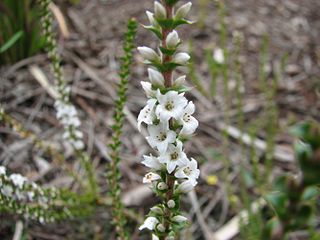
Epacris gunnii is a species of flowering plant in the family Ericaceae and is endemic to south-eastern Australia. It is an erect shrub with hairy branchlets, concave, sharply-pointed, broadly egg-shaped leaves, and tube-shaped, white flowers arranged along the stems.

Persoonia rigida, commonly known as the rigid-, hairy- or stiff geebung, is a species of flowering plant in the family Proteaceae and is endemic to south-eastern Australia. It is an erect to low-lying shrub with hairy young branchlets, lance-shaped to spatula-shaped leaves that are hairy when young, and yellow flowers borne in groups of up to twenty on a rachis up to 90 mm (3.5 in) long that continues to grow after flowering.
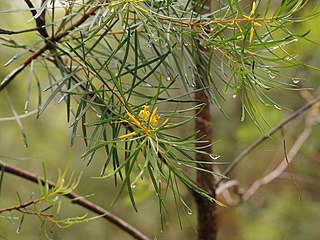
Persoonia virgata is a species of flowering plant in the family Proteaceae and is endemic to coastal areas of eastern Australia. It is usually an erect shrub with smooth bark, hairy young branchlets, linear to narrow spatula-shaped leaves, and yellow flowers borne in groups of up to seventy-five on a rachis up to 230 mm (9.1 in) long that continues to grow after flowering.

Persoonia hirsuta, commonly known as the hairy geebung or hairy persoonia, is a plant in the family Proteaceae and is endemic to eastern New South Wales. It is a hairy, spreading to low-lying shrub with linear, lance-shaped or spatula-shaped leaves and yellow or orange flowers arranged singly or in groups of up to ten on a rachis up to 20 mm (0.79 in) long.

Persoonia muelleri, commonly known as Mueller’s geebung, is a shrub endemic to Tasmania. It forms a shrub in open areas of wet forests in the west and northeast of the state. It is occasionally confused with P. gunnii though it has larger flowers and longer, straighter leaves.
Persoonia rufiflora is a species of flowering plant in the family Proteaceae and is endemic to the south-west of Western Australia. It is an erect, sometimes spreading shrub with hairy young branchlets, lance-shaped to linear leaves, and hairy, greenish yellow flowers arranged singly or in pairs.

Persoonia media is a species of flowering plant in the family Proteaceae and is endemic to eastern Australia. It is an erect to spreading shrub or tree with branchlets and leaves that are glabrous or only sparsely hairy, elliptic to egg-shaped leaves and up to sixteen yellow flowers on a rachis up to 150 mm (5.9 in) long.
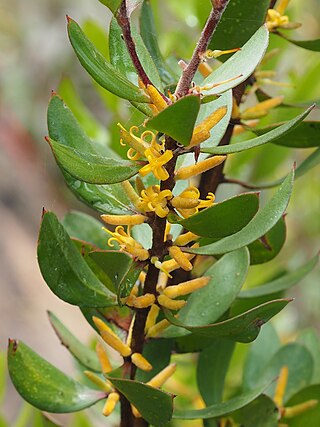
Persoonia oleoides is a species of flowering plant in the family Proteaceae and is endemic to north-eastern New South Wales. It is an erect to low-lying shrub with oblong to egg-shaped leaves and yellow flowers in groups of up to twenty-five on a rachis up to 130 mm (5.1 in) long.

Persoonia daphnoides is a plant in the family Proteaceae and is endemic to a restricted area in eastern Australia. It is a prostrate shrub with spatula-shaped to egg-shaped leaves with the narrower end towards the base, and yellow flowers in groups of up to eight on a rachis up to 35 mm (1.4 in) long.

Persoonia cuspidifera is a species of flowering plant in the family Proteaceae and is endemic to northern New South Wales. It is an erect shrub with spatula-shaped leaves and greenish yellow, tube-shaped flowers in groups of up to twenty-five.
Persoonia spathulata is a species of flowering plant in the family Proteaceae and is endemic to the south-west of Western Australia. It is an erect to spreading shrub with hairy young branchlets, spatula-shaped leaves, and yellow flowers arranged singly or in pairs on a rachis up to 2 mm (0.079 in) long that continues to grow after flowering.

Persoonia trinervis is a species of flowering plant in the family Proteaceae and is endemic to the south-west of Western Australia. It is an erect, sometimes spreading shrub with densely hairy young branchlets, spatula-shaped or lance-shaped leaves with the narrower end towards the base, and densely hairy yellow flowers.
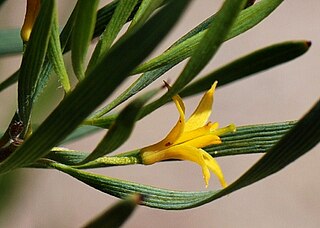
Persoonia quinquenervis is a species of flowering plant in the family Proteaceae and is endemic to the south-west of Western Australia. It is an erect, spreading shrub with hairy young branchlets, twisted linear, lance-shaped, narrow oblong or narrow spatula-shaped leaves, and bright yellow flowers borne in groups of up to ten on a rachis up to 60 mm (2.4 in) that continues to grow after flowering.
Persoonia brachystylis is a species of flowering plant in the family Proteaceae and is endemic to a restricted area on the west coast of Western Australia. It is an erect, spreading shrub with smooth bark, narrow spatula-shaped to lance-shaped leaves and yellow flowers in groups of ten to twenty.

Persoonia saundersiana is a species of flowering plant in the family Proteaceae and is endemic to the south-west of Western Australia. It is an erect, spreading shrub with hairy young branchlets, linear leaves, and bright yellow flowers borne in groups of up to twenty-five on a rachis up to 100 mm (3.9 in) that continues to grow after flowering.

Persoonia comata is a species of flowering plant in the family Proteaceae and is endemic to the south-west of Western Australia. It is an erect, sometimes spreading to low-lying shrub with mostly smooth bark, spatula-shaped to lance-shaped leaves with the narrower end towards the base and yellow flowers usually in groups of ten to fifty along a rachis up to 250 mm (9.8 in) long.

Philotheca virgata, commonly known as Tasmanian wax-flower, is a species of flowering plant in the family Rutaceae and is endemic to south-eastern Australia. It is a slender, erect shrub with wedge-shaped to oblong leaves and white or pale pink flowers at the ends of branchlets. It is the only philotheca with four sepals and petals.

Pomaderris racemosa is a species of flowering plant in the family Rhamnaceae and is endemic to south-eastern Australia. It is a shrub or small tree with densely hairy branchlets, egg-shaped to broadly elliptic leaves, and racemes or panicles of cream-coloured flowers.
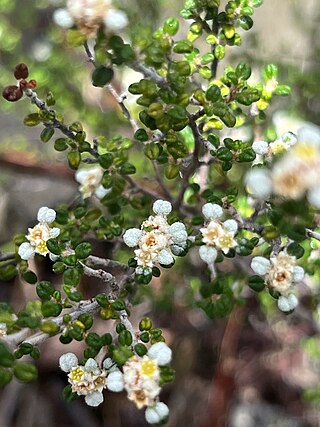
Spyridium lawrencei, commonly known as small-leaf spyridium or small-leaf dustymiller, is a species of flowering plant in the family Rhamnaceae and is endemic to Tasmania. It is an erect, compact or straggling shrub with small, leathery, round to heart-shaped leaves, and dense heads of hairy, cream-coloured flowers.



















